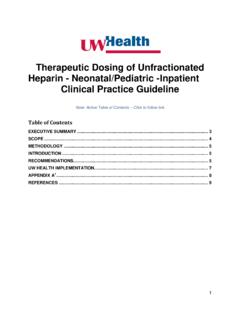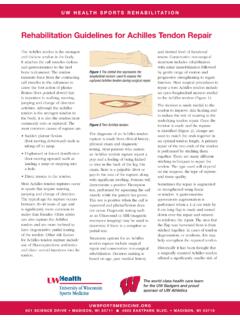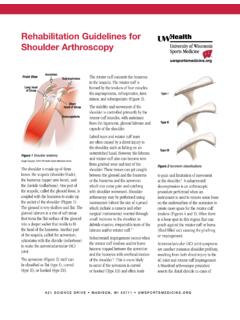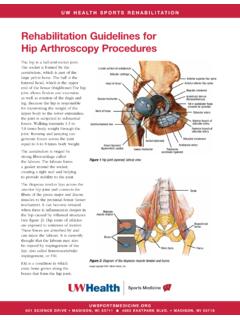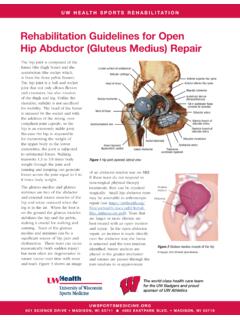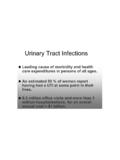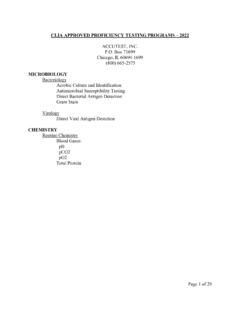Transcription of University of Wisconsin Hospital and Clinics Guidelines ...
1 University of Wisconsin Hospital and Clinics Guidelines for anti -Infective Lock Solutions Guidelines developed by UWHC Drug Policy Program Author: Marie Pietruszka, PharmD Reviewed by: Christopher Crnich, MD; Nasia Safdar, MD; Dennis Maki, MD; Antimicrobial Use Subcommittee Coordination: Sara Shull, PharmD, , Manager-Drug Policy Program, Lee Vermeulen, RPh, MS, FCCP, Director of Center for Clinical Knowledge Management. Approved by P&T: January 2011 Scheduled for Review: January 2013 Background anti -infective lock solutions are used to prevent or treat device-related bacteremias that result from colonization of bacteria within the lumen of an intravascular device. The most common pathogens associated with colonization are cutaneous organisms (Staphylococcus aureus, coagulase-negative Staphylococcus and Candida species), although gram-negative bacilli may also be present.
2 The anti -infective lock technique (ALT) was developed to allow a concentrated antibiotic or antiseptic solution to dwell within the catheter lumen for an extended period of time. Central venous catheters (CVC) or implanted vascular devices can become contaminated with microorganisms by various mechanisms either at the time of insertion or with later use. Micro-organisms can migrate through the percutaneous (extralumenal) route either at the time of insertion or days later. Intralumenal contamination can occur through manipulation of the intravascular device (IVD) hub either at time of insertion or later with device use. Organisms can also travel from a remote source infection via the bloodstream and contaminate the intraluminal surface of the device.
3 1 Device-related bloodstream infection (BSI) usually requires systemic antimicrobial therapy and catheter For needed long-term devices, catheter salvage is often desirable. The instillation of an anti -infective lock solution into the IVD has been studied for both prevention and treatment of long-term catheter-related bacteremia. Studies on the use of ALT for the prevention of IVD-related BSI have shown that vancomycin-containing lock solutions can reduce the risk of device-related infection by approximately 50%.2 The evidence supporting the use of ALT for the treatment of IVDs that are infected is less robust but suggests improvements in salvage rates of 20-30% depending on causative organism. 3,4 To be practical in the acute care setting, the anti -infective lock should display efficacy over a sufficiently short dwell time to be useful in hospitalized patients with competition for intravenous line time.
4 The time required for exposure to the concentrated anti -infective is approximately 60 minutes or longer (if there is not a critical need for access, then the dwell times should extend as long as possible).1 Longer dwell times are possible in patients with hemodialysis catheters or implantable ports that are not routinely accessed on a daily basis. The formation of a biofilm within the catheter lumen limits penetration of anti -infective solution. Bacteria within the biofilm require 100 to 1000 times greater anti -infective concentration to achieve killing versus planktonic Standard intravenous therapy does not reach high enough concentration to reduce bacterial burden within the biofilm of the catheter lumen. Therefore, pharmacologic concentrations of anti -infectives are used in anti -infective lock therapy either alone for prophylaxis or in combination with systemic therapy for treatment of catheter-related bacteremia.
5 Bastani demonstrated that, in hemodialysis patients with dialysis catheter-related infection, systemic vancomycin administration produces a therapeutic plasma concentration; however, during the intradialytic period, the diffusion of the anti -infective from the plasma into the catheter lumen is Use of an anti -infective lock between dialysis sessions is necessary to provide continuous exposure of the bacteria within the catheter to a high concentration of anti -infective. Stability and compatibility of the anti -infective lock solution in combination with an anticoagulant must be considered when ordering an anti -infective lock solution. Temperature, dwell time, addition of anticoagulant or other anti -infectives all influence stability.
6 Antimicrobial activity may be inhibited by addition of an anticoagulant. When ethanol lock solutions are considered, the effect of ethanol on the mechanical and structural integrity of the catheter must be considered. 7 Objectives To provide information to clinicians on the appropriate indications, anti -infective concentrations and dwell times for anti -infective flush and lock solutions in pediatric and adult patients with a variety of catheters. Available regimens based on clinical studies or case reports, not in vitro data. To provide information on stability and compatibility of solutions. To include evidence for anti -infectives available at UWHC. Definitions: anti -infective lock: solution that is instilled into the lumen of a catheter and removed after a specified period of time (or when access device next used).
7 The process of instillation and removal is the anti -infective lock technique (ALT). Indications and regimens approved for the use of anti -infective lock solutions in the prevention and treatment of catheter-related bloodstream infections. All orders for non-HD catheter ALT requires Infectious Disease approval. HD catheter ALT requires either Nephrology of Infectious Disease approval. Prophylaxis 8 Do not routinely use anti -infective solutions to prevent catheter related infections Use prophylaxis with anti -infective lock solutions only in special circumstances. Infectious Disease approval is required for non-HD catheter ALT. Nephrology or Infectious Disease approval required for HD catheter ALT. Vascular access device is required for long term/indefinite use and cannot easily be replaced in a patient with a history of catheter- related blood stream infections despite stringent infection control.
8 Table 3: Prophylaxis Regimens in long-term CVC: pediatric/adult (non-hemodialysis) Listed concentrations for anti -infective(s) and heparin are final concentration per ml of admixed solution. Dwell time minimum one hour. Vancomycin Cipro Ceftaz Heparin Dwell time Reference 25 microgram 2 microgram 10 unit minimum one hour 9 2 milligram (see ) 100 unit 2mL lock between use 10 2 milligram 100 unit 2mL lock between use 10 Abbreviations; Cipro, ciprofloxacin; Ceftaz, ceftazidime For vancomycin 2 mg/100 unit heparin/mL lock listed above, draw vancomycin concentration (peripheral only) at a mid-point between lock instillations to check for detectable vancomycin concentration. The concentration should be non-detectable.
9 Table 5: Adult Prophylaxis Regimen: Hemodialysis Listed concentrations for anti -infectives and heparin are final concentration per mL of admixed solution anti -infective Lock Solution HD Catheter Vancomycin Gentamicin Heparin Reference Vanco + heparin T CVC 2500 units 11 Gent + heparin TCVC 1 milligram 2500 units 11 Abbreviations; Vanco,vancomycin; Gent, gentamicin Although the standard concentration of heparin used for dialysis is 1000uit/mL, the clinical trials used a higher concentration of heparin. Lower concentrations of heparin need to be validated prior to use.
10 Treatment 5,20 Tunneled Central Venous Catheter (CVC) or Intravascular Device (IVD) Catheter removal is the treatment of choice for persistent bacteremia related to CVC use. Remove CVC or IVD if: Complicated infection (endocarditis, septic thrombosis, osteomyelytis, etc.) or Uncomplicated infection with Candida species, Staphylococcus aureus or Pseudomonas aueruginosa. The CVC or IVD should always be removed with device-related Staphylococcus aureus bacteremia since low success rate increases risk of recurrence or endocarditis. Treat with systemic antimicrobial therapy per Infectious Disease recommendation after CVC or IVD removed. The salvage rate for catheters is very low regardless of causative organism and should be considered for removal.
